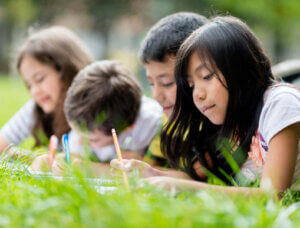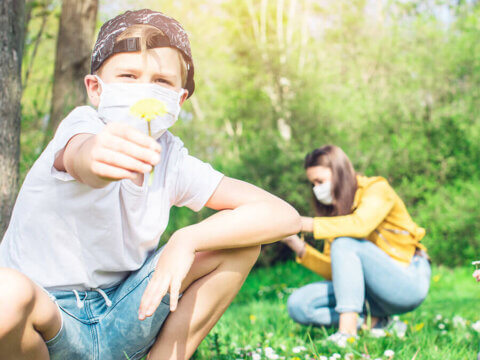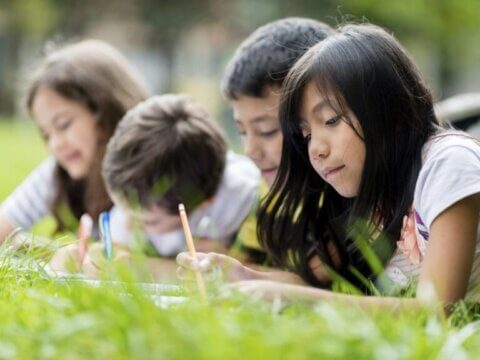GROUNDS FOR CHANGE: Green Schoolyards for all Children
C&NN is pleased to announce “Green Schoolyards for Healthy Communities”, a partnership with the National League of Cities Institute for Youth Education and Families. “Green Schoolyards for Healthy Communities” will engage education leaders, cross-sector practitioners, policy makers and community leaders to promote green schoolyards across the nation. This three-year initiative is funded by a grant from the W.K. Kellogg Foundation.
At a time when children are experiencing high rates of stress, depression, obesity, diabetes and other health risks associated with sedentary lifestyles, they are also experiencing a disconnect from the natural world. The effects of this disconnect are particularly acute in densely populated, economically challenged urban neighborhoods where health risks are already high.
In many neighborhoods, the standard play space is a barren asphalt playground or a concrete slab surrounded by chain link fence — an environment that many people would find unsuitable in a kennel. Too many children have no access to quality school grounds. Too many school districts have decreased or eliminated recess and field trips. Nearly half of school administrators report having cut physical education to increase academic time-on-task. Recent research associates long hours of sitting with a raft of health risks, and yet these trends continue despite the urgency of what public health professionals call a “pandemic of inactivity.”
 At the same time, another growing body of scientific evidence suggests that the creation of nature-rich urban environments, including schoolyards with natural play spaces and gardens, can help improve physical and mental health, cognitive skills, creativity, and social cohesion. New longitudinal studies also suggest that nature-rich schools can help raise standardized test scores. And children in low-income communities appear to benefit proportionally more from access to green space than those in higher-income communities.
At the same time, another growing body of scientific evidence suggests that the creation of nature-rich urban environments, including schoolyards with natural play spaces and gardens, can help improve physical and mental health, cognitive skills, creativity, and social cohesion. New longitudinal studies also suggest that nature-rich schools can help raise standardized test scores. And children in low-income communities appear to benefit proportionally more from access to green space than those in higher-income communities.
Though many policymakers continue to view digital technology as a silver bullet for education, school districts that green their schools can expect a high rate of return on their investment.
Schools can, in fact, be pro-tech and pro-nature. When classroom technology is balanced with hands-on active learning outdoors in natural environments, the benefits of both approaches are multiplied. By using more of their senses, by moving their bodies, by experiencing the awe and wonder of nature, tech-savvy children can maximize the abilities and skills that come from both the natural and the virtual worlds.
Opportunities to take students outside into more natural environments can also reduce teacher burnout, according to one study. Natural schoolyards can strengthen the social fabric of the wider community. During the school day, they provide opportunities for children to play and learn in nature; and when these green oases are opened to the public after hours and on weekends, families spend more quality time together, elders enjoy walking paths and sitting peacefully outdoors among neighbors, and children enjoy more active and independent play in safe places.
The children and nature movement will be effective only in a wider context of social, economic and racial justice. It must value the inherent capacities within communities, including existing social networks, local wisdom and inventiveness and cultural knowledge about the natural world. While not a panacea, the creation of green schoolyards is one way to assure that all children — not just some — receive the gifts of nature so essential to mind, body and spirit.
Green Schoolyards for Healthy Communities
Green Schoolyards: A Growing Movement Supporting Health, Education, and Connection with Nature, a report by Openlands and Healthy Schools Campaign
THE GREEN SCHOOLYARD MOVEMENT: Gaining Momentum Around the World, a Finding Nature News story
How Green Schoolyards Create Economic Value, authored by former Federal Reserve economist Rob Grunewald
Read more about our partner: National League of Cities
Read more about our partner: W.K. Kellogg Foundation
-
Network News
POLICY UPDATE: Policy and advocacy for the children and nature movement
-
Voices
Binoculars, bald eagles and my journey as a Black birder
-
Richard Louv
THE WONDER BOWL: Ten Spring and Summer Nature Activities for Kids and Adults
-
Network News
Minneapolis Spotlight: The promise and possibilities of parks for youth
-
Voices
Why nature is my motherhood ally





Commentaries on the C&NN website are offered to share diverse points-of-view from the global children and nature movement and to encourage new thinking and debate. The views and opinions expressed are those of the author(s) and do not necessarily reflect the position of C&NN. C&NN does not officially endorse every statement, report or product mentioned.